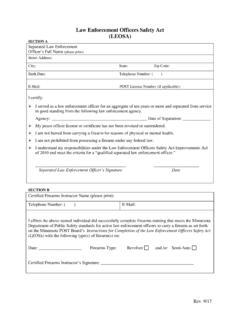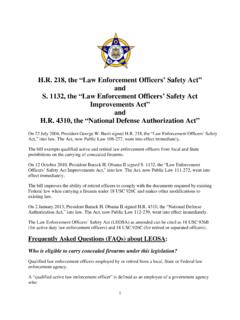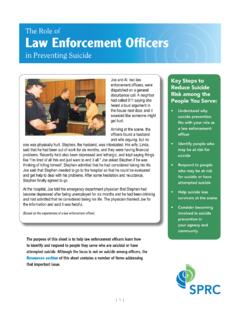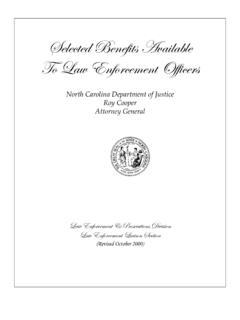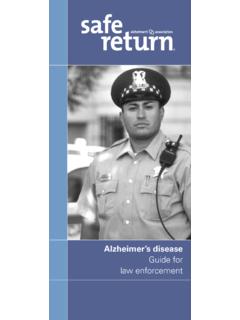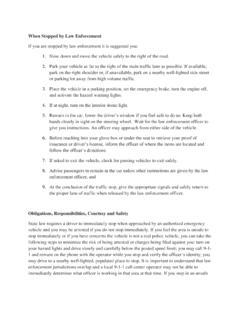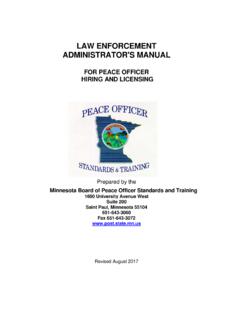Transcription of LEOSA FOR KENTUCKY LAW ENFORCEMENT 2016
1 LEOSA Effective 6/13/ 2016 LEOSA FOR KENTUCKY LAW ENFORCEMENT 2016 KENTUCKY Department of Criminal Justice Training It has been a dozen years since the Law ENFORCEMENT Officers Safety Act, better known as LEOSA , was signed into law in 2004. During that time, there have been several revisions of note, of which active and qualified retired law ENFORCEMENT officers should be aware. The original bill, posted as 218, was signed into law on July 22, 2004, by then-President George W. Bush, becoming Public Law 108-277. It was subsequently codified as 18 926B and C. (Although still commonly referred to as HR 218, once the bill passed and was signed into law, it is more properly called by the name of the Act, its Public Law number or its statutory citation.)
2 As originally passed, active officers and officers who retired after an aggregate of 15 years of service, or due to a service-connected disability, and who had a nonforfeitable right to benefits under the agency s retirement plan, qualified under LEOSA . Subsequently, however, as a result of changes made in 2010, under the Law ENFORCEMENT Officers Safety Act Improvements Act, the number of aggregate years was dropped to 10 years to qualify, and the term retirement was replaced by separation. In addition, the requirement that the officer have rights to retirement benefits was also eliminated. (Further changes added named federal officers and modified the types of ammunition that may be carried.) Finally, in 2013, changes were made to LEOSA as a result of the National Defense Authorization Act (NDAA), 112-239.
3 Those changes clarified and affirmed that military police officers and civilian police officers employed by the government fell under the definitions of the law for both active and retired officers. LEOSA , however, does not give, across the United States, the right for either an out-of-state active officer or a qualified separated officer to carry as an active officer in that state might do. (The rights of officers within the state would be covered by state law.) LEOSA does not completely preempt state and local law. If an officer is carrying under LEOSA , private entities may restrict the carrying of concealed firearms on their premises, and state and local governments may also do so. LEOSA does not supersede the provisions of the federal Gun-Free School Zone Act (GFSZA), either, which prohibits the carrying of a firearm within 1,000 feet of an elementary or secondary school (up through high school).
4 (Under the GFSZA allows on-duty officers to carry, off-duty or LEOSA holders may only carry in that area if they have the rights to do so under their own state law, in their own state.) LEOSA holders must also abide by any federal laws regarding federal buildings and lands, as well as the regulations that apply to air travel. For national parks, pursuant to 36 , an individual may carry a firearm in the park, but not in a federal building, so long as they are in compliance with the laws of the state or states which the park occupies. So, what does that mean for KENTUCKY law ENFORCEMENT officers and retired/separated officers? KENTUCKY law, in fact, extends the rights of LEOSA holders, and gun owners in general, much more broadly than most other states.
5 In KENTUCKY , under the provisions of KRS and KRS , an active officer , who meets the definition of state law provided in KRS , whether full or part-time, may carry anywhere in the Commonwealth, with the only exceptions being the locations specifically listed in KRS 527 such as correctional facilities. (Federal properties, of course, do not fall under KENTUCKY s jurisdiction.) Arguably, however, some categories of officer who do not fall under that law may, in fact, qualify to carry under LEOSA s provisions for active officers. There is continuing debate, but as yet, no resolution, to the issue of how much regulation a law ENFORCEMENT agency, or state law, may place on an LEOSA Effective 6/13/ 2016 active officer who qualifies to carry under the provisions of LEOSA , but who may not so qualify under an individual state s law .
6 For separated officers, the matter is a bit more complicated. To legally carry under LEOSA , a retired officer must have a photographic ID card that indicates that they were employed by the agency that issues the card for at least the requisite number of years and a separate certification that indicates that, not less than one year before, they have qualified with the same type of firearm at the standard set by state law. Under current interpretation, that type would be, for example, a semi-automatic pistol or a revolver, not necessary the same model of firearm. Under KENTUCKY law, the minimum qualification is set in KRS (4), and the same statute indicates who may supervise such qualification.
7 Federal law does not provide any particular format for proof of that qualification. (Although some law ENFORCEMENT agencies include the qualification as part of the identification card that would require a reissuance of the card itself every year.) It also provides for law ENFORCEMENT agencies to set dates for firearms qualification for their own retired officers. KENTUCKY law provides an additional method, however, that effectively provides the officer with both a KENTUCKY CCDW, valid for five years, and a LEOSA card that indicates they have satisfied the retirement and qualification requirements, under KRS , by submitting the required paperwork to the KENTUCKY State Police. (See ) Note, for example, that LEOSA alone does not allow the carrying in a federal park, for example, and having a state CCDW with reciprocity may extend benefits in addition to those provided by LEOSA , depending upon an individual state s laws.
8 (Officers are advised to carry agency retired credentials, as well, as the federal LEOSA law requires that such ID be issued by the officer s agency. Nothing, however, obligates a law ENFORCEMENT agency to provide a duly separated employee with such credentials.) With respect to carrying at locations protected by the GFSZA, reflected in KENTUCKY under KRS , arguably, there is no prohibition in carrying by a retired/separated LEOSA holder, as the latter changes in KRS and KRS both explicitly prevent any such prohibition and allow LEOSA holders to carry anywhere an on-duty peace officer is permitted to carry. This is not necessarily the case in other states, however, as this requires a KENTUCKY state law and not a provision under federal LEOSA .
9 In summary, KENTUCKY officers who are entitled to LEOSA under their active status need only carry photographic identification that indicates their employing law ENFORCEMENT agency, and many such IDs now include such language as part of the identification card itself. Retired/Separated officers require more than simply a retired credential, however, to qualify to carry under LEOSA (and thus also take advantage of the provisions that allow statewide concealed carry in KENTUCKY ) it is also necessary to have, and carry proof, that the holder has qualified with the same type of firearm as required within the last year. Taking advantage of the process offered through the KENTUCKY State Police provides the officer with a state-issued CCDW as well, which may be beneficial in some circumstances.
10 For further information, and the full text of the relevant federal and state laws, please go to the Informational (White) Papers section of the KENTUCKY Department of Criminal Justice Training, Legal Section, website at RELEVANT FEDERAL LAW 18 Code 926B - Carrying of concealed firearms by qualified law ENFORCEMENT officers (a)Notwithstanding any other provision of the law of any State or any political subdivision thereof, an individual who is a qualified law ENFORCEMENT officer and who is carrying the identification required by subsection (d) may LEOSA Effective 6/13/ 2016 carry a concealed firearm that has been shipped or transported in interstate or foreign commerce, subject to subsection (b). (b)This section shall not be construed to supersede or limit the laws of any State that (1)permit private persons or entities to prohibit or restrict the possession of concealed firearms on their property; or (2)prohibit or restrict the possession of firearms on any State or local government property, installation, building, base, or park.
